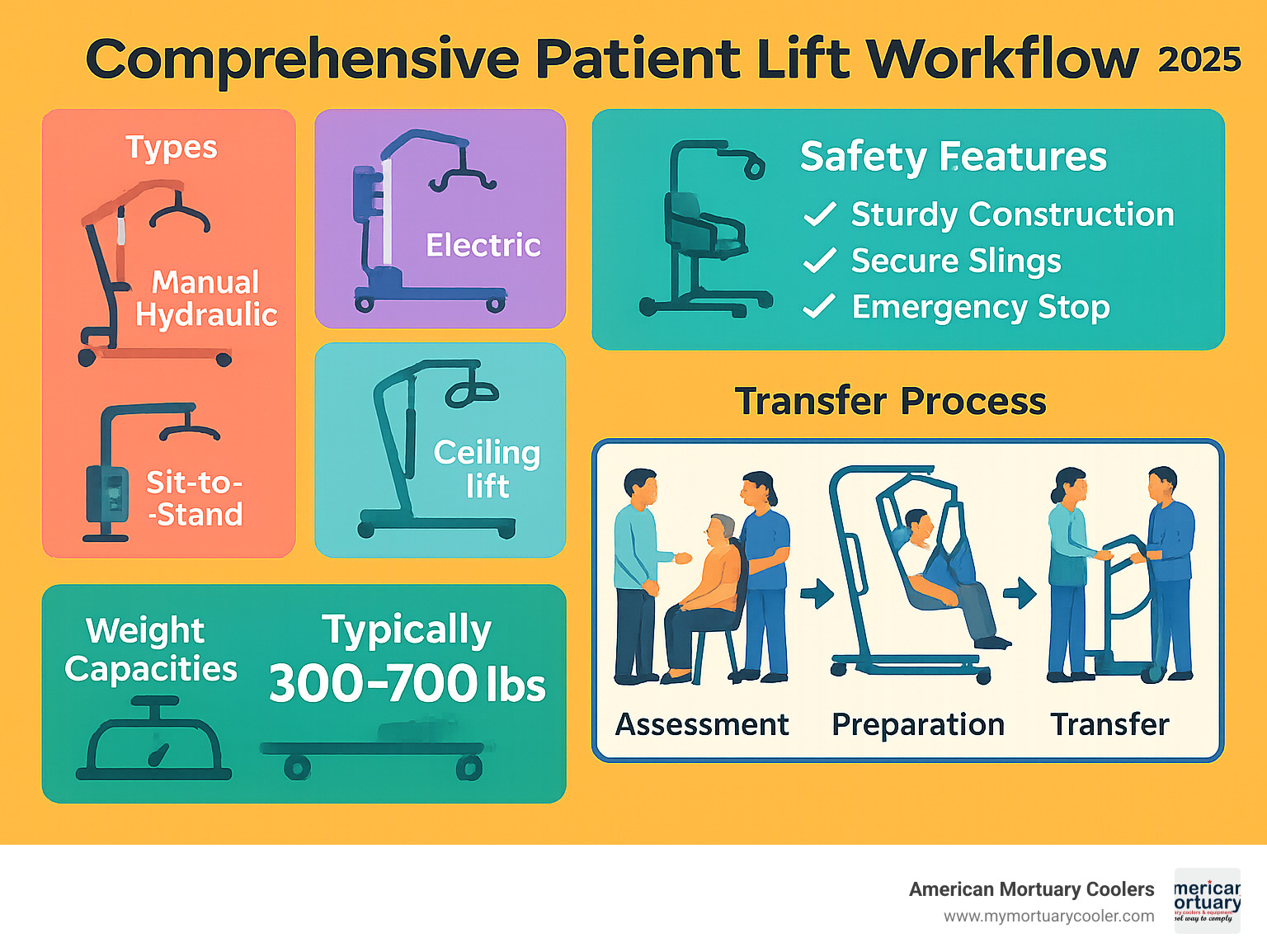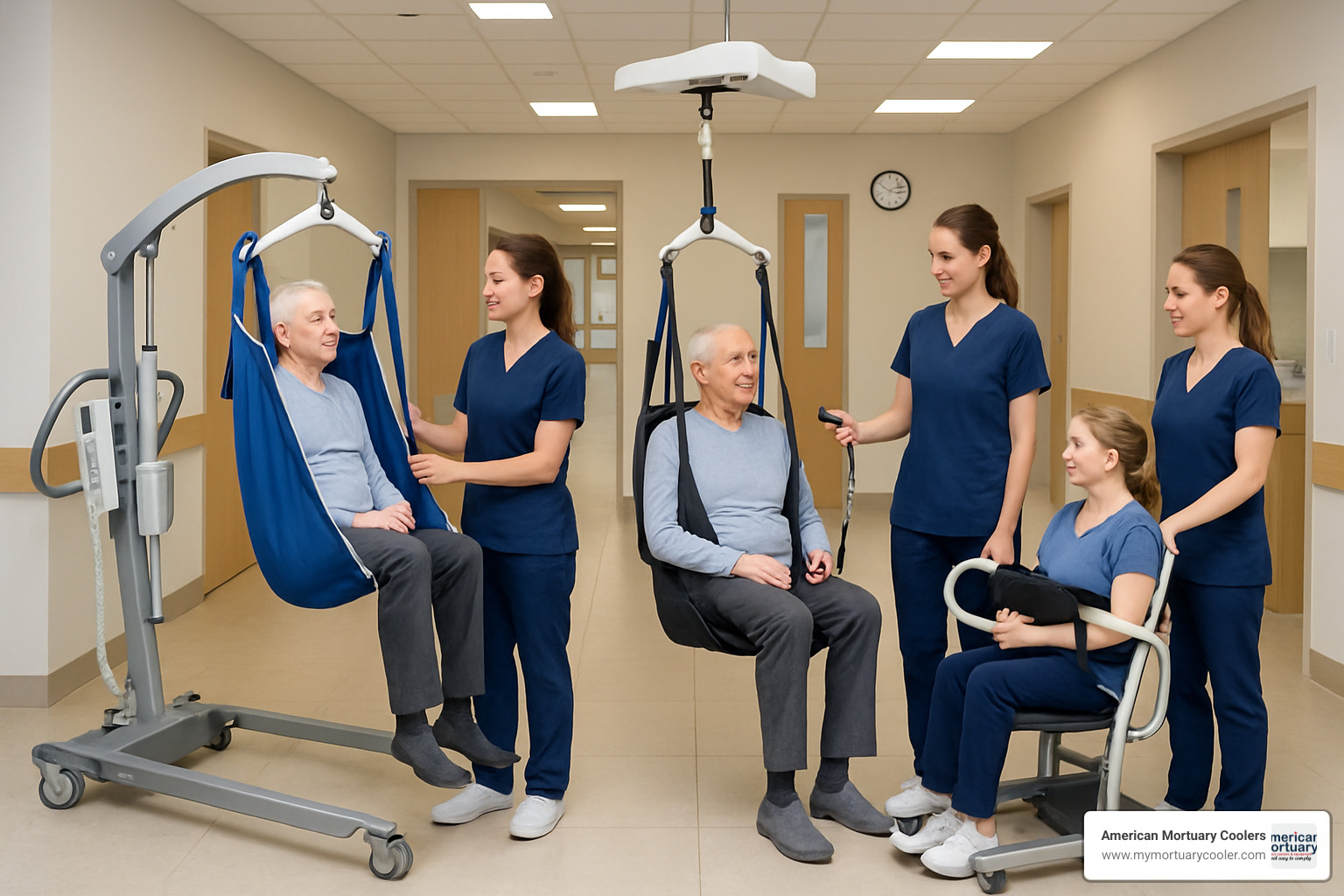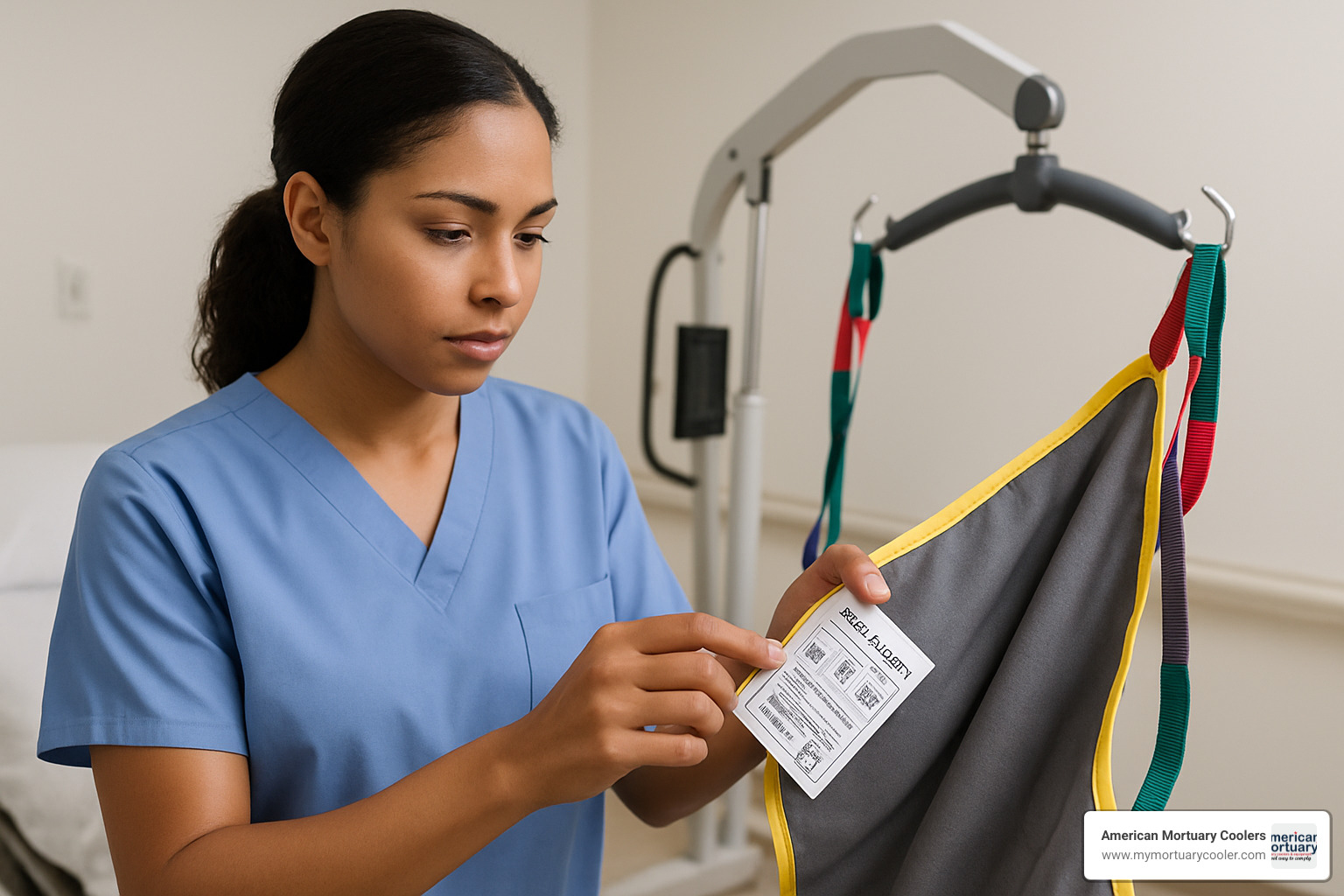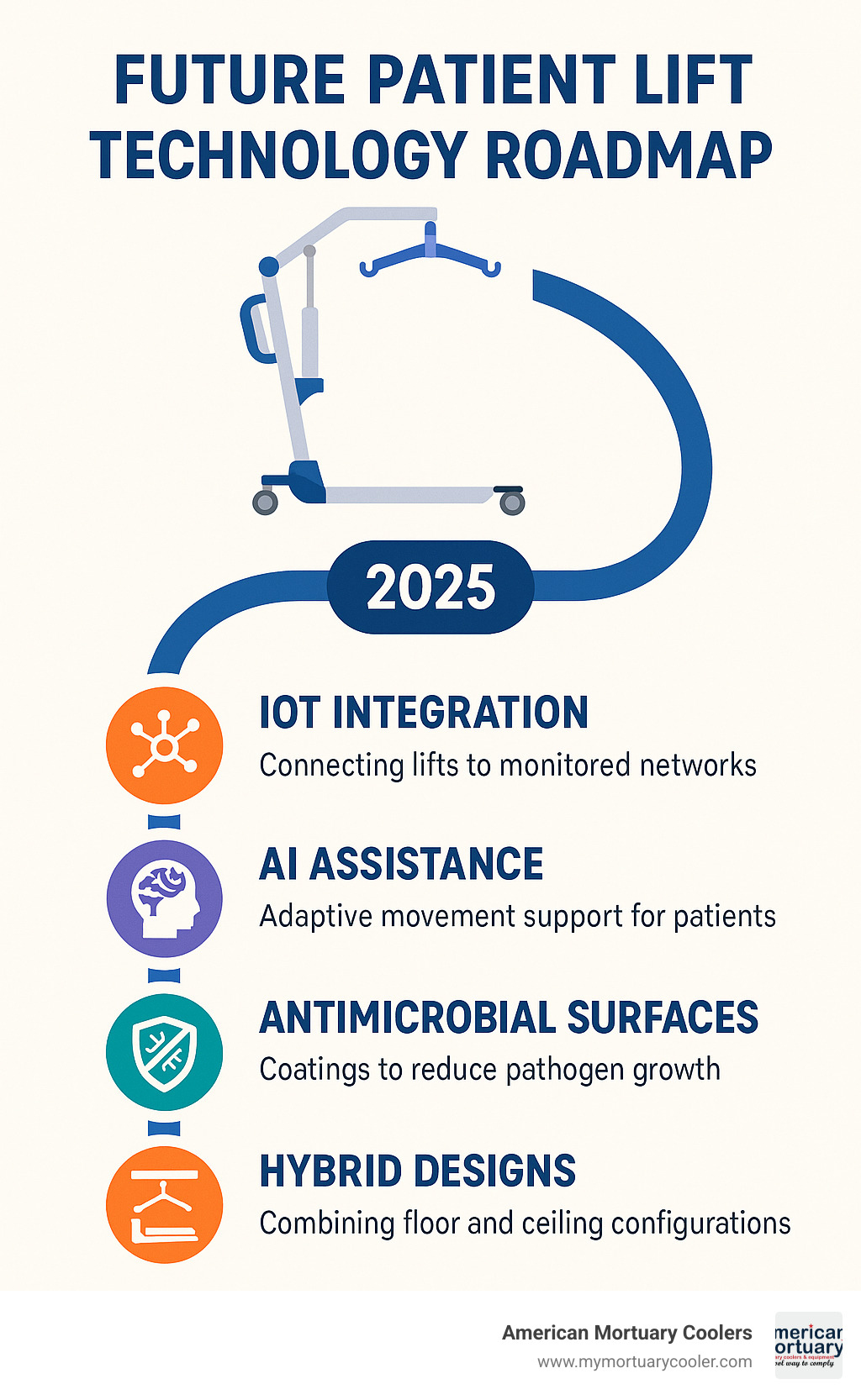Why Patient Lifts Are Critical for Safe Transfers and Caregiver Health
A patient lift is a mechanical device that safely transfers people with limited mobility from one position to another using a sling system and motorized or hydraulic lifting mechanism. These devices are essential for preventing injuries to both patients and caregivers during transfers.
Quick Patient Lift Overview:
- Purpose: Transfer patients safely between beds, chairs, wheelchairs, and toilets
- Main Types: Manual hydraulic, electric/battery-powered, sit-to-stand, ceiling-mounted
- Weight Capacity: Typically 300-700 lbs depending on model
- Key Benefits: Reduces caregiver back injuries by up to 40%, prevents patient falls, maintains dignity
- Cost Range: $1,250 to $7,700 based on features and capacity
- Who Uses Them: Home caregivers, hospitals, nursing homes, assisted living facilities
Manual patient lifting causes up to 52% of nurses to report chronic back pain. Using mechanical patient lifts can reduce caregiver injuries by up to 40% compared to manual lifting methods.
Patient lifts serve anyone who cannot safely transfer independently - from post-surgery patients to individuals with permanent mobility limitations. They're equally valuable for family caregivers at home and professional healthcare staff in facilities.
The technology ranges from simple manual hydraulic pumps to sophisticated electric models with built-in scales and remote controls. Modern lifts can decrease physical effort by up to 90% compared to manual lifting techniques.
I'm Mortuary Cooler, a national-level mortuary cooler supplier with experience in durable medical equipment and patient lift systems for healthcare facilities. My background in reliable, American-made equipment helps guide professionals toward the most effective patient lift solutions for their specific needs.

Similar topics to *patient lift *:
Patient Lift Basics: What They Are, How They Work, and Who Benefits
Understanding how a patient lift works starts with its core components. Picture a sling that cradles the patient like a supportive hammock, connected to a spreader bar that distributes their weight evenly across multiple points. The magic happens through either a hydraulic pump (operated manually) or an electric actuator (battery-powered) that provides the smooth lifting motion. All of this sits on a wheeled base that lets you roll the entire system right where you need it.
The people who benefit most from these devices include patients with limited mobility - whether they're recovering from hip surgery, living with conditions like multiple sclerosis, or simply finding it harder to move safely as they age. But here's what many people don't realize: caregivers might benefit even more than the patients themselves.
Musculoskeletal injury statistics tell a sobering story. Manual patient handling causes chronic back pain in up to 52% of nurses, and these injuries can end careers. Using mechanical patient lifts changes everything - they can reduce caregiver injuries by up to 40% and decrease physical effort by a whopping 90%.
Healthcare facilities see dramatic improvements too. Falls prevention becomes much more manageable when transfers happen in a controlled, secure environment. The efficiency gains add up quickly - what used to require two or three staff members can often be handled safely by one person with the right lift.
The choice between full-body lifts and sit-to-stand lifts depends entirely on what the patient can do. Full-body lifts handle everything when someone can't bear weight on their legs, while sit-to-stand models work with patients who still have some strength and want to stay active in their care.
| Feature | Full-Body Lift | Sit-to-Stand Lift |
|---|---|---|
| Patient Support | Complete body support | Partial assistance |
| Weight Bearing | No weight bearing required | Some leg strength needed |
| Transfer Types | Bed to chair, floor to bed | Chair to standing, toileting |
| Sling Type | Full-body or U-sling | Chest/torso support only |
| Rehabilitation | Maintains mobility | Encourages active participation |
How a Patient Lift Moves a Person Step-by-Step
The heart of any patient lift is the boom and mast system - think of it like a construction crane designed for people. The mast is the vertical post that provides height and stability, while the boom extends horizontally over the patient. Inside this boom, the lift motor does the heavy lifting (literally).
Down below, the base legs spread wide for stability during transfers, then narrow for maneuvering through doorways. Modern lifts often power this adjustment automatically, so you don't have to wrestle with manual levers while managing a patient transfer.
The sling attachment points on the spreader bar are carefully engineered to distribute weight safely. Most systems use either four or six connection points, creating a secure cradle that keeps patients comfortable throughout the transfer.
Full-Body vs. Sit-to-Stand Patient Lift — Key Differences
Full-body lifts are the workhorses for patients who need complete assistance. These lifts handle everything when someone can't bear weight on their legs, lacks trunk stability, or simply can't participate actively in transfers. Think post-surgical patients, individuals with severe neurological conditions, or anyone who needs full assistance during recovery.
Sit-to-stand lifts work with patients who still have partial weight-bearing ability and some trunk control. These patients can follow instructions, place their feet properly, and hold onto support handles. The lift provides security and assistance while letting them stay active in the process.
This difference matters enormously for rehab goals. Physical therapists love sit-to-stand lifts when they're appropriate because they keep patients engaged in their own movement. For toileting access, sit-to-stand lifts often work better because they position patients more naturally and make clothing management easier.
Types of Patient Lift Devices
When you're shopping for a patient lift, the sheer variety of options can feel overwhelming. But here's the good news: each type serves a specific purpose, making your choice clearer once you understand the basics.
Mobile floor lifts are the workhorses of patient transfers. These roll on wheels and can position anywhere you need them - from bedroom to bathroom to living room.
The simplest version is the manual hydraulic lift. You pump a handle (just like a car jack) to raise the patient. The Hydraulic Deluxe Silver Vein Patient Lift at $1,299 represents this reliable, no-nonsense approach. No batteries to charge, no electrical components to break - just dependable lifting power when you need it.
Fully electric lifts take the work out of lifting entirely. Models like the Battery-Powered Patient Lift ($3,095) and the more advanced Reliant 450 Battery-Powered Patient Lift ($3,695) use rechargeable batteries to do all the heavy lifting. These often include bonus features like powered base adjustment and digital displays.
Stand-up lifts serve a special purpose - they're perfect for patients who can bear some weight but struggle to rise from chairs. The Reliant 350 Stand-Up Lift with Power Base ($3,975) excels at toileting assistance and rehabilitation exercises.
Ceiling track lifts mount permanently to overhead tracks, gliding smoothly without any floor obstacles to steer around. While they require professional installation, they're incredibly smooth to operate and save floor space in tight bedrooms and bathrooms.
For those dealing with space constraints, portable and folding lifts offer a compromise. They sacrifice some capacity and features but fold up when not needed - perfect for homes where every square foot matters.
Bariatric heavy-duty lifts handle the toughest jobs, supporting patients weighing 500-700 pounds or more. The Bariatric Battery-Powered Lift at $4,295 shows the specialized engineering these situations demand - reinforced everything, from frames to slings.
Bath and pool lifts work in wet environments where regular lifts would be dangerous. These waterproof units enable safe aquatic therapy and bathing for people with mobility challenges.

Manual vs. Electric Patient Lift Comparison
The manual versus electric debate comes down to effort versus convenience. Manual hydraulic lifts require you to pump a handle, but they're incredibly reliable and cost much less. A basic hydraulic patient lift starts around $1,299, while electric models begin around $3,095.
Electric lifts eliminate pumping effort entirely - just press a button and watch it work. This makes them ideal for caregivers with limited strength or facilities handling multiple transfers daily. Most batteries support 20-30 full lifting cycles, and charging indicators prevent unexpected power loss.
Here's a reassuring detail: most electric lifts include emergency manual lowering capability. If the power fails, you can still safely lower the patient using a manual backup system.
Bariatric Patient Lift Considerations
Bariatric patients need equipment built like a tank. Standard lifts typically max out at 400-450 pounds, while bariatric models support 500-700 pounds or more - that's a significant engineering challenge.
Reinforced frames use heavier gauge steel with additional bracing to handle these loads safely. The spreader bars are wider too, distributing weight across larger sling areas for better comfort and safety.
Heavy-duty slings designed for bariatric patients feature reinforced stitching, wider panels, and higher weight ratings. They often include extra padding and support zones to accommodate larger body sizes comfortably.
Specialty & Niche Lifts You Should Know
Some situations call for specialized solutions. Pool and bath lifts handle wet environments where standard lifts would be dangerous. These waterproof units resist corrosion and include drainage systems.
Stair evacuation chairs serve emergency situations and multi-level homes. Battery-powered models like the MOBI EZ handle 500-pound patients and climb 30 five-story flights on a single charge.
Pediatric models address children's unique needs with appropriate sizing and often colorful designs to reduce anxiety in young patients.
Choosing & Buying Your Patient Lift: Capacity, Features, Accessories, Costs
Selecting the right patient lift starts with one non-negotiable factor: weight capacity. This isn't just about matching the patient's current weight - you need to account for clothing, medical devices, and most importantly, a safety margin. Standard lifts handle 400-450 pounds comfortably, while bariatric models step up to support 500-700 pounds.
Before you fall in love with any particular model, grab a measuring tape. Turning radius and maneuverability can make or break your lift's usefulness. Measure those doorways, hallway widths, and tight corners where you'll need to steer.
Under-bed clearance is another space consideration that catches people off guard. Low-profile bases slide under most standard beds easily, but some models sit higher and might require creative positioning or bed adjustments.
The setting where you'll use your patient lift shapes everything else about your decision. Home users typically prioritize portability and storage - maybe you need something that folds up for the closet or fits in a van for family trips. Healthcare facilities, on the other hand, focus on durability and advanced features that can handle multiple daily transfers.
Powered base adjustment might sound like a luxury, but it's a game-changer for caregivers. Instead of manually cranking those base legs wider or narrower, you simply press a button. Your back will thank you, especially if you're making these adjustments multiple times per day.
Don't overlook battery indicators on electric models. Running out of power mid-transfer isn't just inconvenient - it's potentially dangerous. Quality lifts provide clear warnings and charge estimates, so you're never caught off guard.
Sling compatibility affects your long-term costs and options. Universal attachment systems work with multiple sling brands, giving you flexibility. Proprietary systems might offer better integration but limit your choices down the road.
Some lifts include built-in scales, which eliminate the need for separate weighing procedures. This feature proves especially valuable in healthcare settings where regular weight monitoring is required.
Price ranges span from around $1,250 for basic manual hydraulic models to over $7,700 for advanced electric units with all the bells and whistles. The investment typically pays for itself through reduced caregiver injuries and improved efficiency.
Financing options help manage those upfront costs. Many suppliers offer payment plans, leasing arrangements, or rental programs for temporary needs. Medicare Part B covers patient lifts when deemed medically necessary by a physician for home use, covering 80% of the approved amount after the deductible.
Scientific research on safe patient handling strongly supports mechanical lifting devices for protecting healthcare workers and improving patient outcomes. For more detailed guidance on electric options specifically, check out our comprehensive comparison guide.
Must-Have Patient Lift Features
A six-point cradle system distributes the patient's weight across multiple attachment points instead of just two or four. This isn't just about comfort - though your patients will definitely appreciate fewer pressure points. It's about safety and stability during transfers.
Powered leg spread transforms one of the most physically demanding aspects of lift operation into the simple press of a button. You can widen the base for maximum stability or narrow it to squeeze through doorways without breaking a sweat.
Tool-free folding mechanisms matter more than you might think. When you need to store or transport your lift, the last thing you want is hunting around for special tools or wrestling with complicated procedures.
Alarmed battery systems provide multiple layers of protection against mid-transfer power loss. The best models give you remaining charge estimates, low-battery alerts, and automatic shutdown protection.
Essential Patient Lift Accessories
The universal U-sling serves as your workhorse accessory, handling most routine transfers while leaving the patient's arms free. It's the Swiss Army knife of slings - versatile enough for bed-to-chair transfers and comfortable for most patients.
Divided-leg slings offer improved support for patients with limited trunk control. The separate leg supports provide more secure positioning and can be easier to apply in certain situations.
Commode slings solve the bathroom challenge with strategic openings that maintain patient support and dignity during toileting. These specialized slings eliminate the awkward process of removing and reapplying regular slings for bathroom transfers.
Digital scales integrated into the lift system turn routine transfers into opportunities for weight monitoring. This proves especially valuable in healthcare settings where regular weigh-ins are required.
Safe Operation & Maintenance of Patient Lifts
Operating a patient lift safely starts with developing good habits that become second nature. Before every transfer, take a moment to run through your pre-transfer checklist - it's like buckling your seatbelt before driving. This simple routine prevents most accidents before they happen.
Visual inspection should become automatic. Look for frayed cables, damaged slings, or loose bolts that could spell trouble. Weight-limit verification ensures you're not asking the lift to do more than it's designed for - remember to account for clothing and medical devices too. Proper sling attachment might seem obvious, but it's worth double-checking every time.
Getting the sling positioned correctly takes practice, but it's worth the effort. The sling should cradle the patient comfortably without creating pressure points or cutting off circulation.
Locking those casters is non-negotiable. It's amazing how a lift can drift at the worst possible moment if you forget this step. Always engage the wheel locks before starting any transfer, and give them a quick test to make sure they're holding firm.
Modern lifts include slow raise and lower speeds for good reason. Rushing a transfer makes everyone nervous and increases the chance of problems. Take your time - patients appreciate the gentle approach, and you'll have time to spot any issues before they become serious.
Emergency stop mechanisms are your safety net. Make sure everyone who operates the lift knows exactly where these controls are and how to use them. In an emergency, fumbling around looking for the stop button isn't an option.

Routine maintenance keeps your lift running safely and extends its life. Daily visual checks catch obvious problems, while weekly detailed inspections dig deeper. Monthly comprehensive examinations ensure everything stays in top condition.
Cleaning protocols matter more than you might think. Use disinfectants that won't damage the lift components, and pay special attention to slings and any surfaces that touch patients. A clean lift is a safer lift.
Annual professional servicing isn't just a good idea - it's often required to maintain your warranty. Qualified technicians can spot problems you might miss and handle calibration and safety checks that keep everything running smoothly.
The most important factor in safe operation? Proper caregiver training. Studies show that good training reduces injuries by up to 40%. When caregivers know what they're doing, everyone benefits - patients feel more secure, and staff feel more confident.
Daily Patient Lift Safety Routine
Starting each day with a visual inspection takes just a few minutes but can prevent major problems. Look for anything that seems off - frayed cables, cracked plastic, or loose hardware. Your eyes are often the best early warning system.
Weight-limit verification should be automatic, especially if you're working with different patients. Never push the limits - if someone weighs 380 pounds and your lift is rated for 400, that's cutting it too close when you factor in clothing and safety margins.
For electric lifts, maintaining a charging schedule prevents that sinking feeling when the battery dies mid-transfer. Establish a routine - maybe charging overnight or between shifts - and stick to it.
Preventing Caregiver & Patient Injuries
Even with a mechanical lift doing the heavy lifting, proper body mechanics still matter. Keep your back straight, avoid twisting motions, and position yourself properly when guiding the lift. The lift handles the weight, but you still need to protect yourself during positioning and maneuvering.
Clear transfer paths might seem obvious, but it's easy to overlook that ottoman or forget about the IV pole. Before starting any transfer, take a quick look at your route and move anything that could cause problems.
Communication with patients makes a huge difference in how transfers go. Explain what's happening, let them know what to expect, and keep talking throughout the process. A nervous patient is more likely to tense up or make sudden movements that could complicate the transfer.
Future Trends, Innovations & FAQs
The patient lift industry continues evolving with technological advances that improve safety, efficiency, and user experience. Lightweight portable motors reduce overall lift weight while maintaining lifting capacity, making devices easier to maneuver and transport.
IoT telemetry systems enable remote monitoring of lift usage, maintenance needs, and performance metrics. These connected devices can alert facilities to maintenance requirements, track usage patterns, and provide data for optimizing patient care workflows.
Antimicrobial surfaces address infection control concerns, particularly important in healthcare environments. Advanced coatings and materials resist bacterial growth and simplify cleaning procedures.
Magnetic hand controls, like those featured on the Amico GoLift Portable450, enable quick disinfection by allowing easy removal of control surfaces for thorough cleaning.
Hybrid floor/ceiling units combine the benefits of both lift types, providing ceiling-mounted convenience with floor-based flexibility when needed.
AI gait-training modes represent the cutting edge of rehabilitation technology, providing adaptive assistance that adjusts to patient progress and encourages active participation in mobility recovery.

Frequently Asked Questions about Patient Lifts
What is the average cost of a patient lift?
Patient lift costs vary significantly based on type and features. Manual hydraulic lifts start around $1,250-$1,500, while basic electric models begin around $3,000-$3,500. Advanced electric lifts with features like built-in scales, powered bases, and premium construction can cost $4,000-$7,700. Bariatric models typically add $500-$1,000 to base prices. Don't forget to budget for slings ($89-$200) and accessories, which are often sold separately.
How do I size a sling correctly?
Sling sizing depends on patient measurements and lift type. For Blue Max Slings, chest measurements determine size: small (24-34"), medium (34-44"), large (44-48"), and extra large (48-55"). However, sizing varies by manufacturer, so always consult specific sizing charts. Consider the patient's weight distribution, trunk stability, and any special needs like toileting access.
Are there affordable bariatric options available?
Yes, bariatric patient lifts are available across various price ranges. Basic bariatric manual lifts start around $1,800-$2,200, while electric bariatric models range from $4,000-$5,500. Some manufacturers offer financing options or rental programs to make bariatric lifts more accessible. Medicare Part B may cover bariatric lifts when medically necessary.
Conclusion
Choosing the right patient lift can truly transform someone's life. Whether you're caring for a family member at home or managing patient safety in a healthcare facility, these remarkable devices restore dignity while protecting everyone involved from injury.
The numbers speak for themselves - patient lifts reduce caregiver injuries by up to 40% and eliminate up to 90% of the physical effort required for transfers. But beyond the statistics, these tools give families hope and healthcare workers the confidence to provide excellent care without sacrificing their own well-being.
The investment makes sense from every angle. Basic manual models starting around $1,250 can prevent thousands of dollars in injury costs, while advanced electric units up to $7,700 deliver professional-grade performance for demanding environments. With Medicare Part B covering 80% of costs when medically necessary, quality patient lifts become accessible to those who need them most.
Technology continues advancing rapidly. From IoT connectivity that monitors equipment health to AI-powered gait training that adapts to patient progress, tomorrow's lifts will be even more capable. Antimicrobial surfaces and magnetic controls already address today's infection control challenges, while hybrid designs combine the best features of different lift types.
At American Mortuary Coolers, our commitment to durable, custom equipment extends beyond mortuary solutions to encompass safe handling systems across healthcare environments. Our experience with reliable, American-made equipment from our locations in Johnson City TN, Atlanta GA, Chicago IL, and throughout our regional coverage areas informs our understanding of what makes equipment truly dependable in demanding applications.
Every transfer should be safe, comfortable, and dignified. The right patient lift makes this possible, whether you're helping someone transition from hospital to home recovery or ensuring daily care remains sustainable for years to come. Take time to assess your specific needs, involve healthcare professionals in the decision, and choose equipment built to last.
For more detailed guidance on selecting the right lifting solution for your specific needs, explore our comprehensive resource: More info about Electric Lift Options.
















